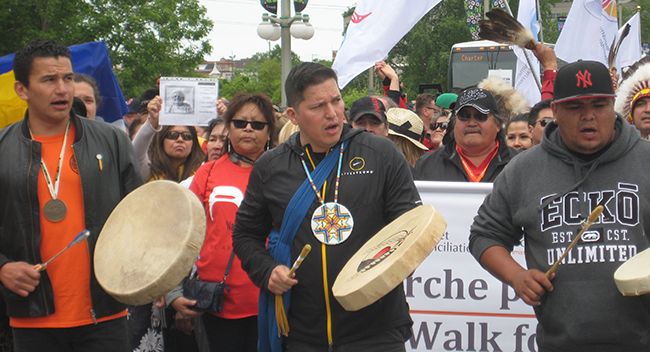‘Canada clearly participated in a period of cultural genocide’: Sinclair

By Suzanne Keeptwo
OTTAWA — Completion of the Truth & Reconciliation Commission (TRC) commenced on May 31 with the lighting of a Sacred Fire and Walk for Reconciliation in the capital city of Ottawa of 10,000 people strong. Talks, workshops, prayers, films, concerts, artworks, impromptu round dances, and information sessions took place at different venues within the city with the core of the action occurring at the Delta Hotel where the commissioners announced their findings.
Seven generations of indigenous children were violated by the federal government and Christian churches’ implementation of a policy of assimilation with intergenerational effects still felt today. After Harper voted against the United Nations Declaration on the Rights of Indigenous Peoples in 2007, followed by what is considered by many as an empty apology in 2008, Elders had to bring the matter of resolution to the Supreme Court of Canada. Church officials were afraid the action would cause financial ruin and the federal government, although eventually signing the UN Declaration in 2010, rejected the implementation of it. Survivors worked together to file a national class action settlement, the largest in Canadian history, resulting in establishing the Truth and Reconciliation Commission.
Thousands of documents were reviewed, 300 communities visited, and seven thousand testimonies were witnessed by TRC commissioners Justice Murray Sinclair, Chief Wilton Littlechild and Dr. Marie Wilson over the last six years. For the first time in Canadian history IRS survivors were publicly acknowledged and now their stories are being heard, documented, danced, sung, beaded, and painted.
“Canada clearly participated in a period of cultural genocide” announced Justice Sinclair. “Imperialism, colonialism, and a superiority complex still exist today. Ninety four recommendations are included in the report including receiving an apology from the Catholic Church for the spiritual abuse of indigenous peoples.
The Report also calls for a National Inquiry for Missing and Murdered Indigenous Women; a Government of Canada Annual Report on the State of Aboriginal Peoples (to not lose momentum of the TRC findings); a National Research Program to Advance the Understanding of Reconciliation; and a National Registrar of Names of those children whose lives were lost while at – or running from – the schools. “There is a list of over 3,000 students-in-spirit and many more whose names or whereabouts remain unknown due to the destruction of documents between 1936 and 1944” revealed Dr. Wilson. She also emphasized the need for educational reform. “How do we teach others about our past? Overt and subtle colonialism is still pervasive. How truthful are our text books? How often is Aboriginal spirituality passed over or excluded from Comparative Religion courses? Indigenous curricula must be created and mandatory for all students. We must have a less Eurocentric vision in this country!”
Chief Littlechild, an Indian Residential School survivor himself, emphasized the importance of honoring the Treaties stating “The UN Declaration provides a roadmap. Like an eagle, with the Declaration of the Rights to Indigenous Peoples on one wing and the Treaties on the other, both are needed in order for Reconciliation to fly”.
Suzanne Keeptwo is a freelance writer residing in unsurrendered Algonquin territory.


